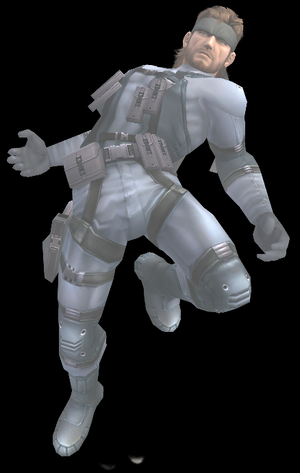Air dodge
Air dodging is a technique in Super Smash Bros. Melee and Super Smash Bros. Brawl that does just as one would expect - it gives temporary invincibility frames to the user in the air, preventing attacks from hitting them. It has sometimes been described as sidestepping in midair.
In Super Smash Bros. Melee
In Melee, an air dodge is performed by fully pressing L or R while in the air. Air dodging cannot be done if the character is tumbling or reeling. The air dodge halts the character's momentum, either leaving him or her hovering if the Control Stick is not tilted or giving the character a small boost in the direction of the Control Stick. This boost can aid one's recovery, though most air dodging characters cannot sweet spot the ledge, and most up Bs outreach the air dodge.
During the air dodge, the character cannot be hit by attacks, but then enters a helpless state and falls to the ground.
Air dodging into the ground is known as wavelanding, which is the primary component of the wavedash.
In Super Smash Bros. Brawl
In Brawl, the air dodge has been revamped. It no longer halts the character's momentum and no longer permits the user to nudge the character by pressing the Control Stick. It simply grants brief invincibility along the character's current line of movement. Following the air dodge, characters are put in their neutral aerial state rather than the helpless state, and thus may attack, jump, or air dodge again following their initial air dodge.
The air dodge can now also be used when a character is tumbling or reeling, and is often employed by players to enable action quicker than waiting out their knockback. Using the air dodge at this time does not reduce knockback, a rumor that was started when it was noticed that higher-level CPUs were doing it constantly (however, by canceling reeling, it does allow the user to use directional influence much earlier).
Air dodge invincibility and lag in Brawl
The numbers before the / are the invincibility frames of the air dodge, and the number after the / is the total number of frames taken to perform the air dodge. For example, Meta Knight's air dodge takes 39 frames to perform, but he is only invincible between frames 3 and 29.
3-29 / 39
4-29 / 39
- Zero Suit Samus
- Diddy Kong
- Pit
- Squirtle
- Ivysaur
- Charizard
- Ike
- Snake
- King Dedede
- Lucario
- Wario
- R.O.B.
- Olimar
4-29 / 48
4-30 / 49
4-29 / 49
- Mario
- Donkey Kong
- Link
- Samus
- Kirby
- Fox
- Pikachu
- Mr. Game & Watch
- Luigi
- Zelda
- Sheik
- Falco
- Yoshi
- Ganondorf
- Wolf
- Toon Link
- Captain Falcon
- Jigglypuff
5-30 / 49
4-19 / 49
Using Air Dodge As A Recovery: Angled Recovery & Elevated Recovery
An Angled Recovery is the opposite of Wavedashing since you angle the control stick Up. An Angled Recovery is useful when you get knocked off a stage that has multiple platforms such as Hyrule Temple. In order to Air Climb, just hold the Control Stick Up Diagonally and Air Dodge. The Angled Recovery has less lag time compared to your character's normal Recovery and it can't be negated since you're invincible except it doesn't go as far as your character's normal Recovery. The Angled Recovery is useful when you're at the peak of your second jump from a short vertical distance off the side of the stage (usually 1.5 inches below the edge of the stage at most) and a short horizontal distance (usually .5 inches away from the stage at most) or you will fall and recieve a Self-destruct. You can also perform this at far distances only if you're at a very high altitude. The Angled Recovery works when your character's second jump doesn't make it to the edge of the stage. Elevated Recovery is just like the Angled Recovery except you don't angle the Control Stick at all. The Elevated Recovery is trickier since you don't move at an angle and you're more likely to fall off the stage since Air Dodging doesn't allow you to Edge-hog and leaves you wide open to attacks during the Helpless phase. But you can move slightly during the Helpless phase. Players with strong Recoveries (including Side Special Moves) such as Falco (Falco Phantasm), Fox (Fox Illusion), Link (Spin Attack), Marth (Dolphin Slash), and Roy (Blazer), rarely need to use the Angled Recovery or Elevated Recovery since their Recoveries are tougher to negate. Angled Recoveries are most beneficial for Jigglypuff and Yoshi, since their up B attacks do not give any recovery distance, though with Jigglypuff its jumps and Rising Pound can usually get it back to the stage anyway. Angled Recoveries are also particularly helpful to a lone Popo, who otherwise has almost no hope of recovery.
Trivia
When an opponent throws an item, if timed right, the air dodge will take the item.
